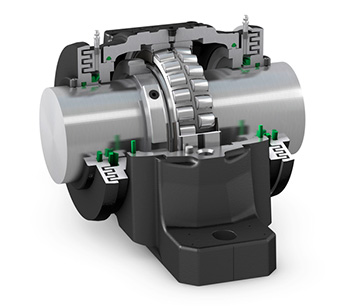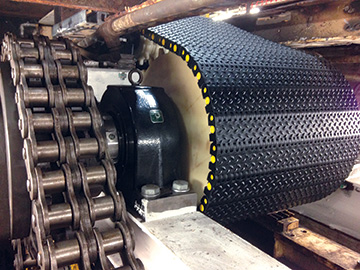Michelle DiFrangia • Assistant Editor

Power-transmission components must satisfy an ever-changing array of industrial design needs, but some trends dominate today’s shifting engineering landscape. These include migration to more customization, the use of new materials, and demand for longer life and durability from all motion components. Here are some related advances that industry professionals see in designs for compression and wave springs, chains, locking assemblies and shaft collars, and seals.
Applications drive new compression and wave spring uses
The need for miniaturized designs continues to drive changes in compression and wave springs. Perhaps the biggest instigator of this trend is the medical industry. “As the population is aging, there’s been expansion of the medical-device industry and corresponding increased use of compression springs,” said Sanjeev Rivera, VP of sales and engineering at Lee Spring. “In particular, a lot of research and development has gone into creating disposable medical technologies.”
In fact, medical applications such as implantable devices or surgical instruments always benefit from being smaller, agreed Ben Moskalik, senior research and development engineer, Smalley Steel Ring Co.
Implant devices are revolutionizing the way medicine is being practiced, said Rivera. “Some operations that would be inpatient procedures, with the help of our springs and product innovation, can now be performed as outpatient procedures.”
The smaller the components, the smaller the tool, the easier it is to handle—a power hand tool, like a cordless drill, for example. “The ability to manufacture smaller diameter springs is the forefront of these technological advances,” added Moskalik. In addition, wave springs in these compact designs offer a slight advantage over coil compression springs. That’s because they get the same spring rate and deflection in about half the length, according to Moskalik.
A wave spring is simply an alternate form of a conventional helical wind spring that lets designers fit comparable loads in tighter spaces. “As more engineers become aware of this benefit, we’ve seen much greater wave spring use in both existing and newly developed applications,” said Rivera.

2016 trends in chains
When it comes to chains, it’s all about longer life, durability and lubrication. “Common in material handling, product transfer and power transmission functions, base chain product as a whole has remained relatively stable,” said Jon Utz, engineering manager, Rexnord. “But there is consistent effort to improve reliability, productivity and product lead times.”
One improvement leading to longer life is a trend toward lubrication-free or self-lubricating chain. Lambda self-lubricating chain from U.S. Tsubaki features hardened self-lube bushings, which are helpful in applications where keeping chain lubricated is difficult or impossible. Consider this application story: A food manufacturer using an O-ring chain was experiencing premature wear. U.S. Tsubaki engineers determined that the O-rings were drying out and failing because they weren’t being properly lubricated. As a result, the chain was lasting about six months shorter than expected—causing unexpected downtime and maintenance, as well as increased costs and lost production. So, the engineering team recommended lube-free Lambda chain as a solution.
“Lambda chain combines oil-impregnated sintered bushings and coated pins for long-term internal lubrication,” explained Michael Hogan, senior roller design and application engineer. Solid rollers engage cleanly with sprockets, creating smooth articulation, recuing chain pull, and lengthening system life. “As a result of switching to the Lambda chain, the customer increased their chain life leading to a significant decline in unexpected downtime,” Hogan said.
Durability problems can be solved with alternative materials, coatings and platings. “Many challenges associated with difficult conditions, often as a result of controlling pollution and a desire for improved environmental protection in applications, can create harsh environments for chains,” said Utz. “Consequently, these environments require continual advances, such as unique product designs and coating technology.”
Engineers should also consider specialized chain when standard product wears out quickly and there are significant maintenance costs involved, according to Utz.
Titan Chain from U.S. Tsubaki is a specialty carbon steel chain specifically designed for difficult environments like the kind Utz described. “The chain has a hard chrome-coated pin plus zinc-coated pin plates,” explained Hogan. “This style of chain has been particularly effective in extending life in the forestry products industry where heavy debris, lack of adequate lubrication and high-speed orientation are prevalent.”
In addition, the company’s new Performax bushing and ring coined connection links are increasing the life of standard chains. The ring coined connection links have a fatigue strength equaling that of a riveted chain link, thus eliminating what was once the weakest link, said Hogan.
Locking devices and shaft collars
Machinery manufacturing and industrial automation are two of the biggest drivers in the development of new keyless locking devices. “The trends that we are seeing have more to do with reductions in assembly and maintenance,” said Jeremy Bigler, product manager, Fenner Drives. “Over the last decade, there’s been stronger focus on providing keyless locking device solutions to meet the customer’s specifications.”

For instance, Fenner Drives recently had a customer that used B-LOC compression hubs on a conveyor that manipulates large panels. The application required several large rotating discs to mount to a line shaft. “The B-LOC Hub let engineers simplify the design by eliminating the need for a welded hub in the large discs,” said Bigler. “They also reduced material and labor costs by eliminating the keyed connection on the line shaft. Prior to the development of B-LOC compression hubs, the customer had to weld in a hub and purchase a standard locking device.”
In fact, engineers at Fenner Drives have developed three new keyless locking devices in the last couple of years:
- B-LOC compression hubs let customers mount thin components such as plate sprockets to a shaft without a hub
- B-LOC Speed locking devices deliver the same performance of popular series and sizes, but install 50% faster
- Trantorque Micro is for servo and stepper-motor applications and features the lowest-profile keyless locking device on the market.
Andrew Brown, president of Whittet-Higgins, also sees a trend toward custom products. “The use of high-speed, super precision, computer-controlled and robotic-fed lathes and machining centers lets us competitively manufacture smaller lot sizes of unique and more complicated parts,” he said.
Brown also sees a growing trend of locking devices being used in applications with gyroscopic stabilization systems.
Shaft collars are beginning to make their way into the medical market with advances in shaft collar technology benefiting robotic surgery designs.
“While cutting-edge technologies enable these designs, the requirement for proven basic mechanical designs and components in these innovations remains,” said Bill Hewitson, VP of operations at Ruland. “Traditional mechanical components, such as shaft collars, can provide structural support, adjustments and mechanical stops. New materials now being used in shaft collars—316 stainless steel, titanium, advanced plastics—offer increased flexibility for engineers designing robotic surgical equipment, for example.”

Engineers traditionally use shaft collars as stops or locators, but are beginning to use them more for mounting components to shafts, according to Arthur Stafford, president and senior engineer, Stafford Manufacturing. “The addition of mounting flats and flanges allow for a single part rather than needing to weld or otherwise connect to separate parts,” he said.
Consider another application, in which a company building astrophysics and meteorology equipment uses a Stafford Accu-Flange Mounting collar to connect hatch arms to open and the close covers on infrared sky imaging cameras. “The flange configuration let them use an off-the-shelf product, saving them development time and cost,” Arthur Stafford said.
In fact, Stafford Manufacturing’s latest introduction, the 3D Freedom series, features one-piece, two-piece and hinged-collar masters, machined in conventional materials and designed to mate with custom printed bushings, to let users immediately create hybrid collars for myriad applications, explained Arthur Stafford.
In addition, recently developed quick-release type collars allow rapid prototyping, offer convenience and save valuable setup time.
New innovations in seals
Every industry presents unique design challenges for seals. “Engineers from these industries are always looking for improvements and pushing the limits for seals,” said John Tranquili, materials manager for Apple Rubber.

Take, for instance, the aerospace industry, which is moving away from chrome plating. “Our dynamic seals must now function effectively on new surfaces, such as ceramic or laser-clad,” said Colin Macqueen, director of technology, Trelleborg Sealing Solutions. The company’s Turcon VL seal is specifically designed for a small groove, making it a popular choice for aerospace applications.
In motion designs driven by fluid power, zinc-free hydraulic oils have caused unexpected surface damage when paired with traditional sealing materials, said Macqueen. To combat this, Trelleborg now offers Turcon M12, a PTFE-based material. “Turcon M12 was designed specifically for these environmentally friendly lubricants—for effective friction characteristics and extended life,” he said.
Reducing friction has always been top priority. Here, rubber-seal improvements have helped most over the past decade. “Adding new filler systems in rubber compounds has helped lower coefficients of friction,” said Tranquili. “Engineered texturing of the mold surface has also reduced the many seals’ working surface area to reduce friction. New coatings that permanently bond to the rubber compounds have greatly reduced friction as well.”
In addition, changes in environmental compliance and new regulations have spurred advances in rubber polymers themselves. For example, HNBR polymers outperform standard Nitrile compounds for ozone and weather resistance, and new grades of FKM are more resistant to steam used to clean piping in the food and pharmaceutical industries, said Tranquili. “These new materials have much better chemical, heat and compression resistance. This allows for less change out or downtime.”
“On the production side,” he continued, “new injection molding press designs give better control for higher precision parts. New mold-making equipment yields better surface finishes and higher cutting tolerances. This gives design engineers less tolerance stack up for assemblies, thus giving less chance of compression issues on the seal resulting in leaks.”

Today’s electric-motor-driven applications also need to last longer and drive the lowest possible torque. Here, seals can reduce the amount of power wasted to overcome system friction. “Traditionally, these applications use standard catalog products and materials,” said Bryan Uncapher, business development manager at SKF. “These trends are requiring us to borrow advanced materials from automotive for industrial applications. Furthermore, we are using design simulation and testing to further optimize sealing lips.”
SKF also sees success in implementing new sealing systems in steel-mill applications previously viewed as a commodity and routine maintenance. “Instead of fixing the problem, one customer focused on cost acquisition instead of cost of operation,” said Uncapher. “Our combination of new seals, different bearings, changes to lubrication intervals, and validation with sensors creates a solution that delivers an ROI of more than 200% in certain circumstances and applications.”
Lee Spring
leespring.com
Smalley Steel Ring Co.
smalley.com
Rexnord
rexnord.com
U.S. Tsubaki
ustsubaki.com
Fenner Drives
fennerdrives.com
Whittet-Higgins
whittet-higgins.com
Ruland
ruland.com
Stafford Manufacturing
staffordmfg.com
Apple Rubber
applerubber.com
SKF
skf.com
Trelleborg Sealing Solutions
tss.trelleborg.com


Leave a Reply
You must be logged in to post a comment.